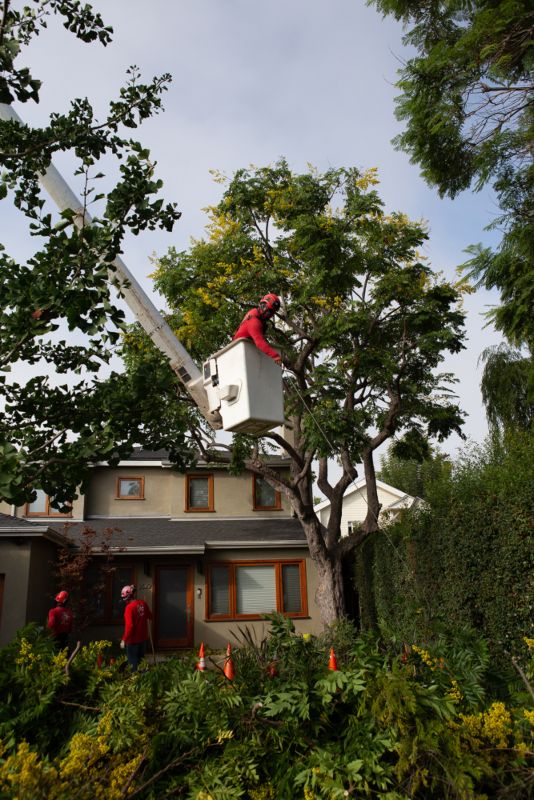Trees are more than just beautiful additions to your landscape! They contribute to the environment, your property’s value, and your overall well-being. But maintaining healthy trees requires regular care and attention. Proper tree maintenance can prevent long-term issues, save costs, and enhance property appeal and safety. Here are nine essential tips to help keep your trees in optimal condition!
Why is Tree Maintenance Important?
Tree maintenance is important for the health and safety of your trees and also provides environmental and economic benefits. Healthy, well-maintained trees are less susceptible to diseases and pests, so they remain robust and beautiful for many years. They enhance property value by adding curb appeal and creating an inviting, aesthetically pleasing landscape.
Environmentally, trees absorb carbon dioxide and release oxygen, combating climate change while providing wildlife habitat, reducing soil erosion, and improving air and water quality. They also offer health benefits, such as providing shade to lower temperatures and energy costs, improving mental health by creating a calming environment, and reducing noise pollution.
Regular maintenance prevents costly issues like emergency removals and property damage, mitigates potential liabilities by reducing safety hazards, and ensures a safer environment for everyone.
9 Tree Maintenance Tips
To keep your trees healthy and thriving, follow these nine essential tree maintenance tips:
1. Proper Pruning and Trimming
Tree pruning and trimming are necessary for optimum tree health and aesthetics. Regular pruning removes dead or diseased branches, promotes healthy growth, and improves the tree’s structure. It’s essential to prune trees at the right time and in the correct manner to avoid damaging the tree. Use sharp, clean tools, and make cuts at a slight angle just outside the branch collar.

2. Water Regularly
Watering is crucial, especially for young or newly planted trees. Trees need deep watering to establish strong root systems. Water deeply and infrequently to encourage roots to grow deeper into the soil. The amount of water needed depends on the tree species, soil type, and weather conditions. Generally, water when the top 6-10” of soil are dry.
3. Use Mulch Around the Perimeter
Mulching helps retain moisture, regulate soil temperature, and suppress weeds. Apply a layer of organic mulch, such as wood chips or bark, around the base of the tree, extending out to the drip line. Avoid piling mulch against the trunk because this can cause rot and attract pests. Mulch should be about 2-4 inches deep.

4. Manage Soil Conditions
Healthy soil is essential for tree growth. Incorporate organic matter, such as compost, into the soil to improve its structure and nutrient content. Beneficial microbes in the soil play a crucial role in nutrient absorption and overall tree health. Pay special attention to soil conditions during planting to ensure the tree has a good start.
5. Don’t Forget to Fertilize
Tree fertilization provides essential nutrients that may be lacking in the soil. Use a balanced, slow-release fertilizer designed for trees, following the manufacturer’s instructions. Fertilize in the early spring or summer to support growth during the active growing season. Avoid over-fertilizing, as this can harm the tree and the environment.
6. Watch Out for Pests and Diseases
Regularly conduct tree inspections to look for signs of tree pests and diseases. Early detection is key to preventing infestations and damage. Look for discolored leaves, unusual growths, or visible insects. If you notice any issues, consult with an arborist to determine the best course of action.
7. Prepare The Trees for the Winter
Winter can be harsh on trees, especially in colder climates. Prepare your trees for winter by watering them thoroughly before the ground freezes. Mulch around the base to insulate roots and protect them from temperature fluctuations. For young or vulnerable trees, consider wrapping the trunk with burlap or tree wrap to prevent frost damage.
8. Remove Invasive Plants
Invasive plants, such as ivy and other climbing species, can damage trees by competing for nutrients, water, and sunlight. They can also cause physical harm to the tree by constricting growth and increasing the risk of disease. Regularly inspect your trees for invasive plants and remove them promptly.
9. Remove Dead Trees
Dead trees can pose significant safety hazards, especially during storms. They are more likely to fall and cause damage to property or injury to people. Regularly inspect your trees and remove any that are dead or beyond saving. Hire a professional arborist to safely conduct a tree removal and prevent accidents.
How to Choose the Right Arborist for Your Tree Maintenance
Choosing the right arborist will make a big long-term difference to you and your trees. Make sure the arborist is licensed and certified, such as by the International Society of Arboriculture (ISA), and has adequate insurance to cover potential damages. Opt for an arborist who offers a comprehensive range of services, including pruning, fertilization, pest management, and tree removal, to efficiently address all your tree care needs. With more than 20 years of experience, our team of Certified Arborists is dedicated to caring for you and your trees. Contact us today!






